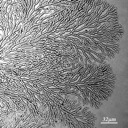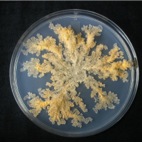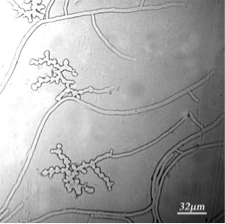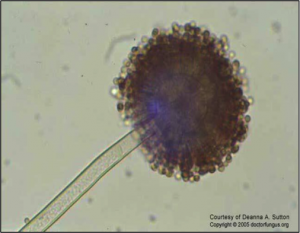By: Nils Nelson
Since the rise of evolutionary theory stemming from Darwin in the 1840s the mystery of the exact processes of inheritance and evolution has begun to unfold. Though it was not until 1970 that the first organism’s genome was sequenced, there was a trail of key developments in proving genes existence and purpose that resulted in the now immense field of genetics and our understanding of biology today.
In 1941 George Beadle and Edward Tatum published a paper on the relationship of genes to enzymes in the fungus Neurospora crassa first reported in French bakeries in 1843 (Beadle, Tatum. 1941). This became known as the one gene-one hypothesis, which later became the one gene-one polypeptide theory. This discovery became the foundation for solving genetic code and brought the fields of biochemistry and genetics together. Beadle and Tatum proved their hypothesis by first mutating sexual spores of the fungus with x-rays and ultraviolet light then isolating mutated spores. Next they selectively bred compatible strains with mutants then grow the resulting genetic offspring on nutrient deprived agar growth medium. Carefully they added the precursors for a specific nutrient and track when an enzyme was not present to convert the pre product molecules. This led them to be able to narrow down the defect of a single gene to the absence of a single enzyme. Today there is a current project attempting to produce a knockout mutant strain of N. crassa mutant for each gene in the genome.
This was not the end of the road for scientific insights provided by N. crassa. The ability to determine the phenotype of all four products of individual meiosis granted insight into the function of genetic recombination in all eukaryotes and became principle evidence for the adaptive function of recombination and out crossing (Murray, 1960). This fungus gave us the first evidence for gene conversion which is a correction mechanism during genetic combination of combatable partners. Another genetic protection system first reported in N. crassa was repeat-induced suppression in which haploid genomes are scanned for duplicate genes, and if found, are polarized by a released mutagen which acts to silence or methylate a genetic element. Studies on N. crassa additionally proved that fungi were eukaryotic which developed our understanding metabolic pathways in all eukaryotes (Davis 2000). Lastly, on the scientific glory list from this fungus is that it was involved with the discovery of mitochondria in 1953. Today, N. crassa is still studied extensively for discoveries in genetics, epigenetics, circadian rhythms, and molecular processes. It is also used in education (Dunlap 1999; Dunlap 2000; Dunlap 2008). This fungus has earned the title of a model organism due to its history of study and usefulness. Some of these useful attributes include a largely haploid life cycle, fast life cycle (10 days), genetic simplicity, wide distribution, and availability of strains. Some of my favorites include “frost”, “cum”, “it pokes along”, and “microcycle blastoconidiation”. The entire genome for N. crassa was sequenced in 2003.
Photos: Fungal Genetics Stock Center. http://www.fgsc.net/cultureimages/morpholpix.htm

Jacobson David. Stanford University. http://www.fgsc.net/Neurospora/sectionB4.htm
N. crassa is a fungi in the class ascomycota. It reproduces both asexually via structures called conidia and sexually via structures called asci. N. crassa ascospores are found to only germinate upon a heat treatment of atleast 60C. This has to do with its life strategy in ecology. N. crassa grows primarily in circum boreal regions, although it has recently been found in temperate region. It occurs on wood and vegetation after forest fires where it appears as a red to orange dust or cotton appearance. Although in lab N. crassa has been studied exensively, much is still unknown about its functions in nature. Due of its relationship with heat it became a bane for bakeries and remains a common contaminant today. N. crassa remains one of the most important organisms of genetic study to date in addition to a slew of other findings and developments in biology. Not only did this fungus vastly increase our understanding of fungi it provided us with key insights into the functions of higher eukaryotes such as ourselves. It is amazing to me how open ended the possibilities for us to increase our biological understanding with fungi. We have the ability now to deeply investigate and study these organisms with the advent of sterile environments, gene sequencing, staining, computing etc. Further inquiry into this comparatively untouched field will become increasingly significant to progress in biology.
Sources:
Beadle, G. W., and E. L. Tatum, 1941 Genetic Control of Biochemical Reactions in Neurospora. Proc Natl Acad Sci U S A 27: 499-506.
Davis, R., 2000 Neurospora: Contributions of a Model Organism. Oxford University Press, New York.
Davis, R., 2000 Neurospora: Contributions of a Model Organism. Oxford University Press, New York.
Dunlap, J. C., 1999 Molecular bases for circadian clocks. Cell 96: 271-290.
Dunlap, J. C., 2008 Salad days in the rhythms trade. Genetics 178: 1-13.
Murray, N. E. 1960. Complementation and recombination between Methionine-2 alleles in Neurospora crassa. Heredity 15:207–217.
Websites:
Gavric Olivera. Images of Neurospora Morphological Mutants in Culture. Fungal Genetics Stock Center. http://www.fgsc.net/cultureimages/morpholpix.htm
Neurospora Crassa Life Cycle. Wikipedia. http://en.wikipedia.org/wiki/File:Neurospora_crassa_life_cycle.jpg
Jacobson David. Stanford University. http://www.fgsc.net/Neurospora/sectionB4.htm






